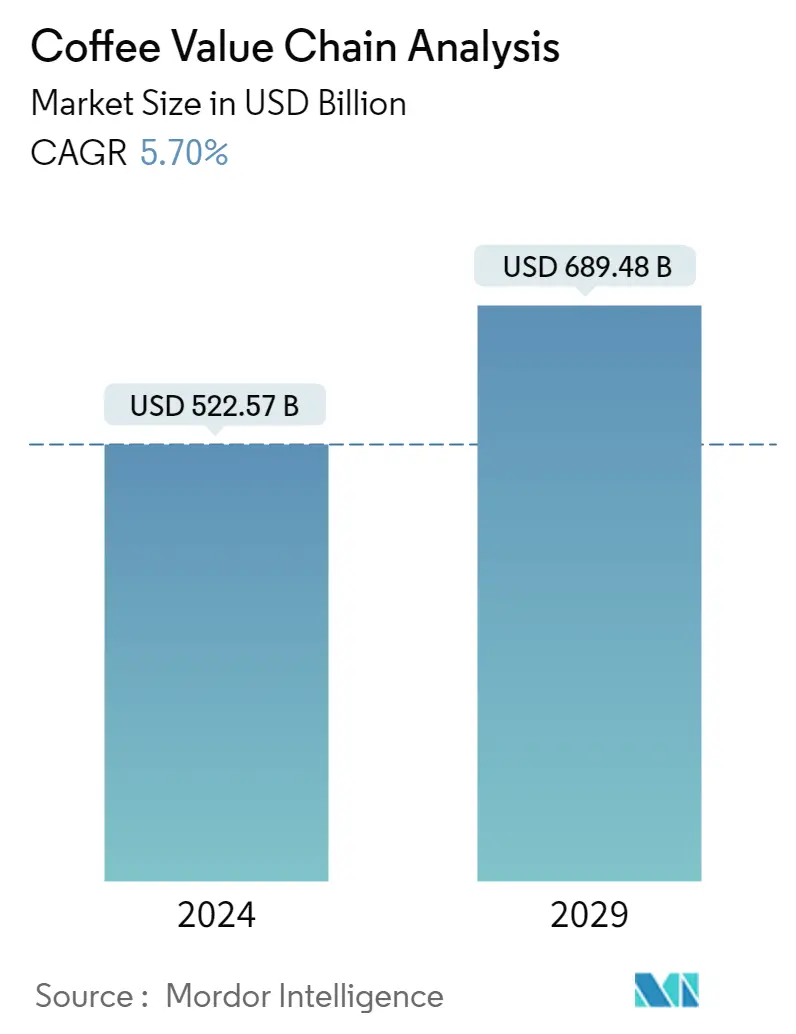Market Size of Coffee Value Chain Analysis

| Study Period | 2019 - 2029 |
| Base Year For Estimation | 2023 |
| Forecast Data Period | 2024 - 2029 |
| Market Size (2024) | USD 522.57 Billion |
| Market Size (2029) | USD 689.48 Billion |
| CAGR (2024 - 2029) | 5.70 % |
Major Players*Disclaimer: Major Players sorted in no particular order |
Coffee Value Chain Market Analysis
The Coffee Market size is estimated at USD 522.57 billion in 2024, and is expected to reach USD 689.48 billion by 2029, growing at a CAGR of 5.70% during the forecast period (2024-2029).
- Coffee is produced in more than 50 developing countries in South America, Africa, and Asia and is an essential source of income for more than 20-25 million families worldwide. The initial production of coffee beans is highly labor intensive. It involves several labor-intensive activities, such as farming, collecting, and processing. Hence, these activities are performed in labor-abundant countries. However, roasting and branding are capital-intensive activities in the coffee supply chain and are therefore situated in the northern industrialized countries. The structure of the value chain is very similar to producing as well as consuming countries. The coffee value chain comprises four main phases: cultivation, processing, roasting, and consumption. Each step in the process has environmental, social, economic, and governance issues that affect the future sustainability of extracting coffee beans.
- On the consumer front, the promotion of coffee by the government, coupled with investment in R&D by major companies, is expected to stimulate the market's growth during the forecast period. For instance, In April 2022, Lulu Hypermarket in the Kingdom of Saudi Arabia, in cooperation with the Ministry of Culture, launched the Year of Saudi Coffee 2022, a great promotion meant to draw attention to the culinary and cultural significance of Saudi-grown coffee beans and it's unique traditional and symbolism as a marker of Saudi hospitality.
- However, the coffee industry has various issues, from farms to markets, such as poor labor practices, unfair wages, deforestation, air pollution from roasting plants, and irregular pricing of coffee, acting as a barrier to the market.
Coffee Value Chain Industry Segmentation
Coffee beans are small dark-brown beans roasted and ground to make coffee. The scope of the report considers the value chain of raw coffee beans. The report covers a detailed supply chain analysis and value chain analysis of the coffee industry at a global level. A typical coffee value chain system involves the operation of five major segments: coffee bean production, sourcing and trading, marketing, processing, distribution, and retailing to the final consumers. Stakeholders across the value chain, the price margin at each stakeholder level, and issues prevalent in the coffee value chain are also provided in the report.
Coffee Value Chain Analysis Size Summary
The coffee industry is a significant global economic sector, with its value chain encompassing cultivation, processing, roasting, and consumption. This industry is predominantly based in developing countries across South America, Africa, and Asia, where coffee farming is a crucial source of income for millions of families. The initial stages of coffee production are labor-intensive, requiring substantial human resources, while later stages such as roasting and branding are more capital-intensive, often located in industrialized northern countries. The coffee value chain faces various challenges, including environmental and social issues, which impact its sustainability. However, government promotions and investments in research and development by major companies are expected to drive market growth. The increasing demand for certified coffee, which assures consumers of environmentally friendly and socially responsible practices, is also contributing to market expansion.
Brazil stands out as a dominant force in the global coffee market, producing a significant portion of the world's coffee supply. The country's favorable climate and extensive coffee plantations, particularly in regions like Minas Gerais, Sao Paulo, and Parana, support its leading position. Brazil's coffee industry is characterized by a shift in production areas to regions with optimal growing conditions, reflecting its adaptability and resilience. The market is further bolstered by initiatives such as the Indonesia Coffee Enterprise Resilience Initiative and Nestle's commitment to sustainable farming practices, which aim to enhance the sustainability and resilience of coffee production globally. These efforts, alongside regulatory support in countries like India, underscore the industry's focus on sustainability and quality, driving future growth prospects.
Coffee Value Chain Analysis Market Size - Table of Contents
Coffee Value Chain Analysis Market Size FAQs
How big is the Coffee Market?
The Coffee Market size is expected to reach USD 522.57 billion in 2024 and grow at a CAGR of 5.70% to reach USD 689.48 billion by 2029.
What is the current Coffee Market size?
In 2024, the Coffee Market size is expected to reach USD 522.57 billion.

